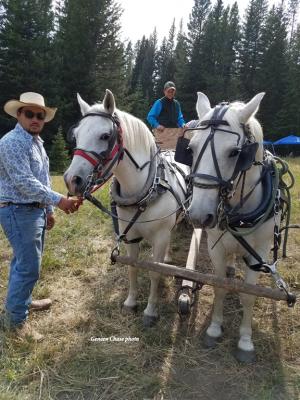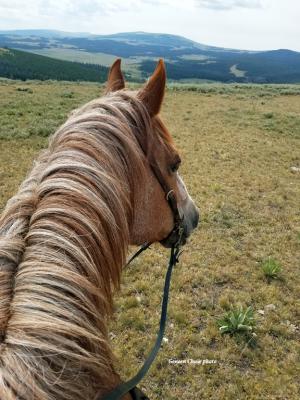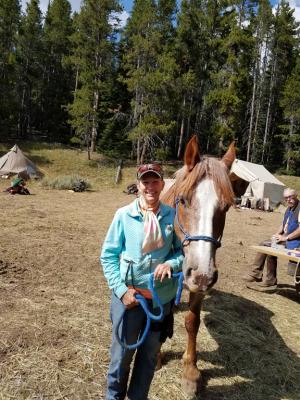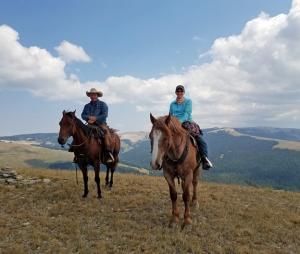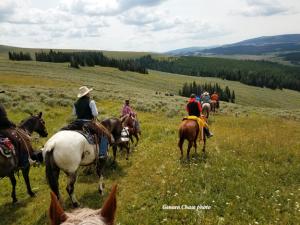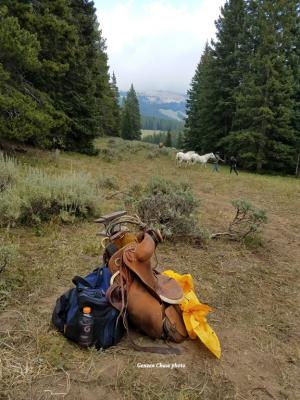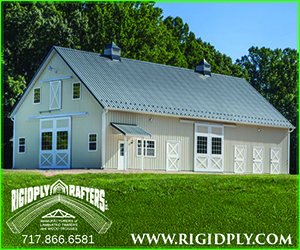By Geneen Chase
The western slopes of the Big Horn Mountains are on Charlie’s and my bucket list to explore. And you can guess our destination for this summer's road trip – the Big Horn Mountains.
Each summer, Ken McNabb hosts 5-day pack trips through the Big Horn Mountains from his base in Lovell, Wyoming. On these trips guests can ride a Ken McNabb trained horse through the incredible scenery of the mountains and enjoy a western camping experience. Provided is gourmet Dutch oven cooking around the campfire, with main courses such as rib eye, wild game stew and barbeque. Awake from range tents in the fresh mountain air to a hot, fresh breakfast and cowboy coffee.
McNabb grew up in a traditional ranching family in the mountains of Wyoming, so this is all “home” to him. In addition to traveling across the country with horsemanship clinics, Ken McNabb manages a large cattle ranch. He raises ranch horses, trains them, and puts on a sale every year. His brother Darold works for the Sheriff's department and trains search dogs for police work.
Getting There
I flew into the Billings, Montana airport, where a shuttle service provided by Ken McNabb drove me three hours to Lovell, Wyoming. Then we headed east toward the Big Horn Mountains National Forest, through the northeast area called Wagon Wheel, where ranchers can range their cattle for the summer.
Base Camp
My next shuttle was a supply wagon that carried supplies up the trail for the final mile to base camp, which I would call home for the next five days. There, White Mountain Outfitters provided my tent and cot and plenty to eat. Master Dutch oven cook, Janeen Blackburn, served three wonderful meals a day with the kindest spirit and smile. A fire was going at all times and there was plenty of cowboy coffee and hot water for hot chocolate. And, of course, there were horses. If you wished to ride in your own saddle, you could have it shipped out. Otherwise, they provided the tack.
The first night at base camp the temperature dropped to 20 degrees. My Tang bottle and water bottle were frozen in my tent. Ice was on the inside and outside of my tent. To say I was cold and did not sleep all night was an understatement! But I was warned in DeeDee McNabb’s e-mail to bring your heaviest winter coat and a sleeping bag that was rated to 20 below. My sleeping bag was rated to 0 degrees – I thought. The cold air was coming up from underneath my cot. I couldn't wait for first light and to hear someone getting the campfire going. Fellow Tennessean Kimber Goodman got up before Janeen and had the fire going. Fortunately that was our coldest night. I put forth a plan not to experience a repeat cold night. Darold loaned me an extra sleeping bag and I layered a saddle blanket under my cot.
Around the Campfire
This is all part of camping in the mountains – cowboy coffee, warming around the campfire, and swapping stories. Most of Ken’s family go ahead of Ken and set up, and then Ken arrives like the rock star. This time he arrived late because he had preached two church services for the only two churches in a 50-mile area. His father is the local preacher and Ken filled in for him.
McNabb has a very outgoing, people-engaging personality and is a great story teller. Of course, he had a bear story.
I enjoyed listening to the stories of life and horse experiences shared around the campfire. There were about 25 of us in all, plus McNabb's family and friends. And of course there were the canines: several Australian Shepherds and Darold's loyal German Shepherd.
The guests were all fairly serious “hobby” equestrians. Four ladies from Ohio, retired from their careers, were checking off their bucket list trail riding vacations. One couple from Pennsylvania were in a quest to ride horses in every state of the U.S. One man was a serious trail rider from Michigan with gaited mules. A fellow Tennessean, owner of Circle G Guest Ranch in Lynnville, Tennessee, Kimber Goodman, is also quite a hand with a horse. And what drew us all there? Horses.
Trail Rides
We had two all-day rides through the trails in the mountains. We took a pack horse along, and had a picnic lunch in a lush meadow filled with wild flowers. The horses were unbridled and allowed to graze, too. Then appearing as if planned, a moose family came out of the willows and posed: a cow, a calf and a young bull.
From base camp at about 8,500 feet, we traveled through Lodgepole pine forest, crossed creeks, and through lush meadows. Then about 9,000 feet, we got above the timberline and on an Alpine meadow with rolling mountain tops. We flushed out some timber grouse; saw herds of Elk and Mule Deer.
Duke
Ken had nice, well trained Quarter Horses from the family's personal ranch horses, or horses that were selected for this job. They were very responsive and willing.
Duke was my equine hero. He could do all the things the Quarter Horses could do, but he was the only Draft cross. Draft crosses are popular because of their disposition. Some outfitters believed they would make good pack horses, but Ken found that Duke’s heavy weight and size make it harder on the horse climbing the hills. Duke did slow down in the steep parts, but he had a steady work pace all day. He was careful with every step, and I just stayed out of his way.
Duke always had his ears up and was willing to go. You know you are one with your horse when you are engrossed looking at the vast scenery left and right and you glance down and your horse’s head is moving in unison with yours. In five days, I spent more saddle time with this horse than in the five years with my own horse in my backyard.
Not only did Duke give me the “scenic cruise” ride, but he proved himself a rock when things got tough. One of our all-day rides had an unexpected glitch in the plans. It was after our lunch break and about two hours into the afternoon with an hour to camp. A meadow that had been dry and crossable was now a marsh and not crossable. We spent an hour trying to bushwack through the forest and find a way around. The men chopped and sawed trees, while young wranglers were sent ahead to scout a passable trail, all the while trying to manage the pack horse.
The younger, more inexperienced horses that the wranglers were on were just about spent. Since Duke and I were usually bringing up the rear, on two occasions, the young horses had a mental shut down. Duke knew what he had to do: ease down, step by step, and help guide and encourage the youngsters out of the tight spot. That day was 26 miles in the mountains and 12 hours in the saddle.
On Ken McNabb Horsemanship
Nearly 20 years ago when the era of “Horse Whispering” was becoming popular and being made available directly to horse owners, I audited clinics with the first generation clinicians: Ray Hunt, John Lyons, Monty Roberts, Buck Brannaman, and Pat Parelli. Before my pack trip, my only knowledge of Ken McNabb was one 30-minute TV program. Since my trip, I have watched his program every week.
In his shows, he has a good balance of talking time and action time. One thing he said that stuck with me is: “You need to ride with confidence and your horse needs to know you are confident. If you aren’t, you need to lie to your horse. … Go back and do the thing you know you can do; then try again at the new challenge.” He talks about the importance of development in training your horse. After watching his program, I felt that I could ride my horse with confidence, and I didn't have to spend hundreds of dollars on CDs or special training tools.
McNabb emphasizes keeping your horse’s attention focused on you and he shows you how to do that in an easy, simple method. He likes helping people and is very user friendly. What he says regarding horsemanship makes sense and is doable. He offers an intense three-week training program and teaches three-day clinics around the country. On April 19-21, 2018 Ken will be at Circle G Guest Ranch in Lynnville, Tennessee.
From listening to the other guests and from my personal observation, I find that Ken is a good teacher. Since his livelihood is ranching, his horsemanship is about riding the rough terrain, not the show ring. He is spot-on with the challenges and problems trail riders encounter. Horses can be a bit more jazzed up and intimidating outside the security of an arena. Ken addresses these issues and has simple dos and don’ts that the average person can use.
I recommend Ken McNabb rides and would definitely go again. The trial rides provided beautiful scenery, good horses, tasty home cooked meals, and spell binding stories – memories to keep for a lifetime. What stands out are Ken’s values and principles. He is a genuine American cowboy.
The western slopes of the Big Horn Mountains are on Charlie’s and my bucket list to explore. And you can guess our destination for this summer's road trip – the Big Horn Mountains.
Each summer, Ken McNabb hosts 5-day pack trips through the Big Horn Mountains from his base in Lovell, Wyoming. On these trips guests can ride a Ken McNabb trained horse through the incredible scenery of the mountains and enjoy a western camping experience. Provided is gourmet Dutch oven cooking around the campfire, with main courses such as rib eye, wild game stew and barbeque. Awake from range tents in the fresh mountain air to a hot, fresh breakfast and cowboy coffee.
McNabb grew up in a traditional ranching family in the mountains of Wyoming, so this is all “home” to him. In addition to traveling across the country with horsemanship clinics, Ken McNabb manages a large cattle ranch. He raises ranch horses, trains them, and puts on a sale every year. His brother Darold works for the Sheriff's department and trains search dogs for police work.
Getting There
I flew into the Billings, Montana airport, where a shuttle service provided by Ken McNabb drove me three hours to Lovell, Wyoming. Then we headed east toward the Big Horn Mountains National Forest, through the northeast area called Wagon Wheel, where ranchers can range their cattle for the summer.
Base Camp
My next shuttle was a supply wagon that carried supplies up the trail for the final mile to base camp, which I would call home for the next five days. There, White Mountain Outfitters provided my tent and cot and plenty to eat. Master Dutch oven cook, Janeen Blackburn, served three wonderful meals a day with the kindest spirit and smile. A fire was going at all times and there was plenty of cowboy coffee and hot water for hot chocolate. And, of course, there were horses. If you wished to ride in your own saddle, you could have it shipped out. Otherwise, they provided the tack.
The first night at base camp the temperature dropped to 20 degrees. My Tang bottle and water bottle were frozen in my tent. Ice was on the inside and outside of my tent. To say I was cold and did not sleep all night was an understatement! But I was warned in DeeDee McNabb’s e-mail to bring your heaviest winter coat and a sleeping bag that was rated to 20 below. My sleeping bag was rated to 0 degrees – I thought. The cold air was coming up from underneath my cot. I couldn't wait for first light and to hear someone getting the campfire going. Fellow Tennessean Kimber Goodman got up before Janeen and had the fire going. Fortunately that was our coldest night. I put forth a plan not to experience a repeat cold night. Darold loaned me an extra sleeping bag and I layered a saddle blanket under my cot.
Around the Campfire
This is all part of camping in the mountains – cowboy coffee, warming around the campfire, and swapping stories. Most of Ken’s family go ahead of Ken and set up, and then Ken arrives like the rock star. This time he arrived late because he had preached two church services for the only two churches in a 50-mile area. His father is the local preacher and Ken filled in for him.
McNabb has a very outgoing, people-engaging personality and is a great story teller. Of course, he had a bear story.
I enjoyed listening to the stories of life and horse experiences shared around the campfire. There were about 25 of us in all, plus McNabb's family and friends. And of course there were the canines: several Australian Shepherds and Darold's loyal German Shepherd.
The guests were all fairly serious “hobby” equestrians. Four ladies from Ohio, retired from their careers, were checking off their bucket list trail riding vacations. One couple from Pennsylvania were in a quest to ride horses in every state of the U.S. One man was a serious trail rider from Michigan with gaited mules. A fellow Tennessean, owner of Circle G Guest Ranch in Lynnville, Tennessee, Kimber Goodman, is also quite a hand with a horse. And what drew us all there? Horses.
Trail Rides
We had two all-day rides through the trails in the mountains. We took a pack horse along, and had a picnic lunch in a lush meadow filled with wild flowers. The horses were unbridled and allowed to graze, too. Then appearing as if planned, a moose family came out of the willows and posed: a cow, a calf and a young bull.
From base camp at about 8,500 feet, we traveled through Lodgepole pine forest, crossed creeks, and through lush meadows. Then about 9,000 feet, we got above the timberline and on an Alpine meadow with rolling mountain tops. We flushed out some timber grouse; saw herds of Elk and Mule Deer.
Duke
Ken had nice, well trained Quarter Horses from the family's personal ranch horses, or horses that were selected for this job. They were very responsive and willing.
Duke was my equine hero. He could do all the things the Quarter Horses could do, but he was the only Draft cross. Draft crosses are popular because of their disposition. Some outfitters believed they would make good pack horses, but Ken found that Duke’s heavy weight and size make it harder on the horse climbing the hills. Duke did slow down in the steep parts, but he had a steady work pace all day. He was careful with every step, and I just stayed out of his way.
Duke always had his ears up and was willing to go. You know you are one with your horse when you are engrossed looking at the vast scenery left and right and you glance down and your horse’s head is moving in unison with yours. In five days, I spent more saddle time with this horse than in the five years with my own horse in my backyard.
Not only did Duke give me the “scenic cruise” ride, but he proved himself a rock when things got tough. One of our all-day rides had an unexpected glitch in the plans. It was after our lunch break and about two hours into the afternoon with an hour to camp. A meadow that had been dry and crossable was now a marsh and not crossable. We spent an hour trying to bushwack through the forest and find a way around. The men chopped and sawed trees, while young wranglers were sent ahead to scout a passable trail, all the while trying to manage the pack horse.
The younger, more inexperienced horses that the wranglers were on were just about spent. Since Duke and I were usually bringing up the rear, on two occasions, the young horses had a mental shut down. Duke knew what he had to do: ease down, step by step, and help guide and encourage the youngsters out of the tight spot. That day was 26 miles in the mountains and 12 hours in the saddle.
On Ken McNabb Horsemanship
Nearly 20 years ago when the era of “Horse Whispering” was becoming popular and being made available directly to horse owners, I audited clinics with the first generation clinicians: Ray Hunt, John Lyons, Monty Roberts, Buck Brannaman, and Pat Parelli. Before my pack trip, my only knowledge of Ken McNabb was one 30-minute TV program. Since my trip, I have watched his program every week.
In his shows, he has a good balance of talking time and action time. One thing he said that stuck with me is: “You need to ride with confidence and your horse needs to know you are confident. If you aren’t, you need to lie to your horse. … Go back and do the thing you know you can do; then try again at the new challenge.” He talks about the importance of development in training your horse. After watching his program, I felt that I could ride my horse with confidence, and I didn't have to spend hundreds of dollars on CDs or special training tools.
McNabb emphasizes keeping your horse’s attention focused on you and he shows you how to do that in an easy, simple method. He likes helping people and is very user friendly. What he says regarding horsemanship makes sense and is doable. He offers an intense three-week training program and teaches three-day clinics around the country. On April 19-21, 2018 Ken will be at Circle G Guest Ranch in Lynnville, Tennessee.
From listening to the other guests and from my personal observation, I find that Ken is a good teacher. Since his livelihood is ranching, his horsemanship is about riding the rough terrain, not the show ring. He is spot-on with the challenges and problems trail riders encounter. Horses can be a bit more jazzed up and intimidating outside the security of an arena. Ken addresses these issues and has simple dos and don’ts that the average person can use.
I recommend Ken McNabb rides and would definitely go again. The trial rides provided beautiful scenery, good horses, tasty home cooked meals, and spell binding stories – memories to keep for a lifetime. What stands out are Ken’s values and principles. He is a genuine American cowboy.
